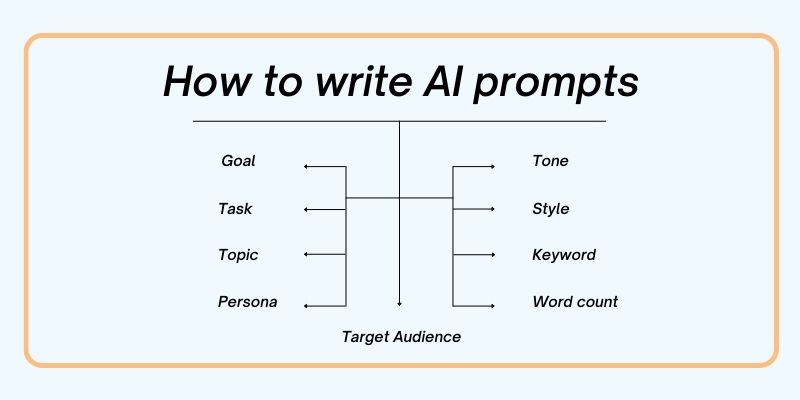As the popularity of AI marketing grows, marketers need to sharpen their skills in writing prompts to make the most of their investment in AI tools. While these tools will become easier to use and more efficient over time, you still need the right variety of AI prompts to generate the desired responses.
We help you navigate this learning curve so you can write effective prompts that meet your diverse business needs. Read on to understand the mechanics of AI coding and how to write effective AI prompts for better results. Also, learn about different types of prompts and their use cases.
What are AI writing prompts?
An AI prompt is a type of interaction between the user and the AI application that allows the model to generate the desired result. They optimize the efficiency of AI platforms, streamlining data processing for valuable insights and engaging content generation.

AI prompts are both an art and a science, requiring human intuition and creativity to formulate queries and combinations that activate an AI tool’s inherent prompt logic. Only then can you fully utilize your AI tool and get the insights and ideas you need.
AI tools help you eliminate time-consuming tasks and save time and energy on planning and scheduling. With effective AI prompts, you can use these tools to gain valuable insights from social media and customer experience data.
Also, create engaging content such as product reviews, blog posts, and social media posts. This is especially helpful because content creation is one of the most time-consuming tasks for marketers, according to “Webdotnine“.

Plus, AI prompts help you tailor content to a global audience, adapting to different organizations to reach more people. You also have the flexibility to adapt the tone and writing style accordingly, which is a crucial part of AI customer service.
With this in mind, let’s take a look at different AI writing prompt tools needed for different tasks.
Types of AI Prompts
The 2023 State of Social Media report found that 93% of business leaders plan to invest more in AI and ML to improve customer service on social media in the next three years. This shows that brands are getting more comfortable with using AI for marketing and other tasks. Now, it’s not about if they’ll use AI, but how they’ll use it.

Good writing prompts boost your creativity and guide you to write more thoughtfully, improving your ability to achieve your goals. Let’s explore the different types of AI writing prompts and how they serve different purposes.

1. Creative Prompts
It is used to create interesting and creative content based on audience preferences. It contains long and short text, pictures, music, and videos. An example of AI writing is “Create a social media post on New Year’s Eve,” and a longer example is “Write a welcome email to an existing (insert: new) customer right now.”
Creative prompts can also be used to create content that simulates a particular writing style. For example, “Write a short essay on the origin of the social media name Mark Twain.”
If you’re using an image generation tool, a good message might be: “Create an image of a child swimming in the pool.”
2. Informational Prompts
These prompts are used to gather information from big data for decision-making. For example, to monitor a competing brand, the message might be: “Tell me a brief history of how Tesla became successful.”

3. Reasoning Prompts
It is used to make decisions about the topic and is useful for creating compelling content. For example, “What is the impact of building a strong community on social media platforms?”
4. Listicle Prompts
These multi-purpose prompts are utilized to compile lists of options, such as email subject lines or blog titles. For instance, “Generate a list of blog titles focusing on the importance of an efficient content calendar.”
5. Instructional Prompts
They help generate content that provides advice. They serve a variety of purposes, such as customer service AI or creating a guide for a new team member. An instructional prompt could be, “Explain the steps required to upgrade from the Standard plan to the Enterprise plan.”
6. Interactive Prompts
These prompts provide interactive and versatile conversations. For example, to train a human resources team, a prompt might be, “Imagine this is a job interview, and I am interviewing a candidate for the role of social media manager.”

7. Keyword Prompts
These prompts consist of words or phrases closely related to the desired outcome of generative content. These are mostly for data insights or for creating images or videos.
How do AI prompts work?
The proposal for writing an AI should be very specific and include everything necessary to get an optimal response. Here’s why this is necessary.
AI prompts heavily depend on natural language processing (NLP). This technology helps the tool interpret the questions written in a conversational format and generate relevant answers. NLP algorithms analyze all the data in queries while machine learning and other AI functions work together to produce the appropriate result. This process consists of three stages:

1. Asking a query
The AI writing prompts are analyzed using natural language understanding (NLU), a second function of NLP. This technology helps the tool recognize the context of the query so that other AI and machine learning functions can take the necessary steps to get the right response.
2. Processing the query
The AI model scans available data to find relevant information using secondary functions such as named entity recognition (NER) and intent recognition. Entity extraction and part-of-speech (POS) tagging identify relevant keywords and details, such as the task type (e.g., writing a blog post), style (e.g., creative or formal), or word count (e.g., 100).
Sentiment algorithms analyze the content information and determine the tone based on the person’s intent. They change the answer according to the appropriate vocabulary and style as NLP algorithms choose the right words, grammar, and syntax to produce the action.
3. Answering the query
This function uses natural language generation (NLG), which combines various information based on the query string in an instant to get the response. Neural networks (NNs) operate in the background, which helps the tool retain the query’s context throughout the interaction. This allows the tool to remember previous requests and generate responses that match current interactions.
Finally, the tool provides the most accurate response based on its training and the writing style of AI (creative, lists, keywords, etc.)
How to Write Effective AI Prompts
The prompts for writing AI should be clear, concise, and simple so that the AI tool can understand the task accurately. To get the best possible response, each question should be optimized based on important factors such as topic relevance, keyword choice, format, and target audience. Let’s get inside.

1. Goal: Specify the purpose of your project. Want to create a social media post, customer feedback, email, or blog? Because this type of subject has its own style, it can only be handled effectively if you focus on the goal.
2. Task: Your written prompt cannot include more than one task. Each new task should be a separate query. For example, if you want to create a list of popular clothing brands with short descriptions and rank them by popularity, break it into two separate queries.
The first prompt could be, “Create a list of the most popular clothing brands and rank them by popularity.” After the tool has generated the list, enter another prompt: “Compose short descriptions for each brand on the list.”
3. Topic: Specify the subject matter of your content. Whether it’s a healthcare product, environmental concerns, or a specific industry, providing a clear topic ensures targeted and relevant responses.
4. Target Audience: Think about who you are creating content for. Does your target audience fall within the age range of 30 to 40 years old? Are you writing for a professional group, such as lawyers or teachers? or Is your content aimed at the customers you want to convert?
5. Persona: Personality: Describe the persona in terms of its key characteristics, key roles, and key responsibilities. For example, an executive AI writing prompt might read: “Write a blog for business leaders about data security for a SaaS company.” Specifying the persona is important because it helps the AI tool choose the correct vocabulary from the database and use it in the story.
6. Tone: Choosing the right tone for your content will make it more appealing and engaging. This is especially useful in business communication with customer care. Specifying a tone, such as assertive, cheerful, empathetic, or friendly, helps the AI analysis algorithms select the right words and phrases to match the tone you specify.
7. Style: Specify how you want the response to be answered. For example, you can ask for the output to be presented in bullet points, paragraphs, or prose.
8. Keyword: Be clear about what you want in your response. The more specific you are about your query, the more accurate the result will be.
9. Word count: Lastly, define the desired word count. This helps the AI determine how long or short the response will be. In this way, the tool can decide how much and what details are relevant to include in the response.
Including several of these elements in your prompt will help you get the best response from your AI tool. Think of each of these elements as keywords that you want to include or exclude from your prompt as required.
Things to remember
Even when an AI tool generates answers conversationally, its understanding of nuances and content is limited. To overcome this issue, follow these steps.
Provide clear instructions.
- If you don’t get the response you want, rephrase your queries. It will also help you match your style.
- If you are looking for a specific answer, ask a closed-ended question.
- Include as much relevant information as possible in your query.
